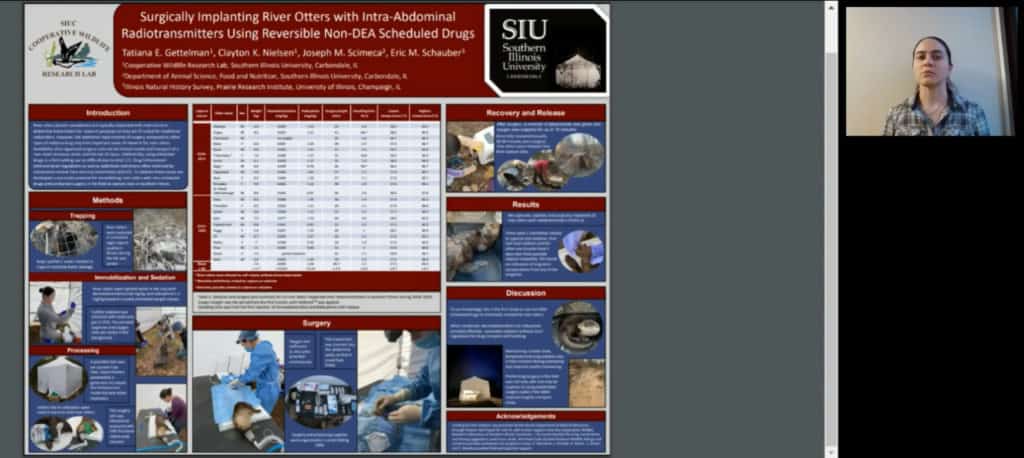Share this article
TWS2020: River otter surgery project gets top poster award
For most mammals, fitting them with a tracking device means placing a telemetry collar around the neck. Not so with river otters. Their narrow heads allow a collar to slip off too easily, and their semi-aquatic activity puts them at risk of drowning if the collar snags on a rock or a branch.
“We can’t do the usual ‘collar and foller’ that is the tradition in this field,” said Southern Illinois University graduate student Tatiana Gettelman.
Yet for survival studies, like the one Gettelman was working on in her advisor Clay Nielsen’s lab, radiotelemetry is essential. That means surgically implanting a cigar-shaped device into a river otter’s (Lontra canadensis) abdomen. But veterinary surgery suites aren’t always available. Tighter and tighter regulations by the Drug Enforcement Agency on the scheduled drugs used to sedate wildlife make it harder to find a professional who can administer them. And stricter protocols on university facilities by the Institutional Animal Care and Use Committee regulations can make it harder still.
“From those I’ve spoken to, they only expect that trend to continue,” Gettelman said.
With a grant from the Illinois Department of Natural Resources, Gettelman and her colleagues developed a protocol to sedate river otters using non-scheduled drugs and perform surgery in the field. Their poster on the protocol was named Best Student Poster Presentation at TWS’ 2020 Virtual Conference.
“It was a very unexpected honor,” Gettleman said. “I showed the poster to my dad and let him listen to the talk, and I joked that he was one of four people who would listen to it.”

Tatiana Gettelman presents her poster on field surgery on river otters at TWS’ 2020 Virtual Conference. Credit: TWS
In the fall and winter of 2018 and 2019, her team used a combination of non-scheduled drugs to sedate the otters — drugs that had already been used successfully on other wildlife. Estimating the otters’ weights to determine the proper dose, they injected the drugs dexmedetomidine and nalbuphine into an otters’ hind leg and maintained the sedation with isoflurane using a portable vaporizer.
“We knew this combination could be effective,” Gettelman said. “We knew similar combinations had been used on wildlife, so we had a fairly high level of confidence that it would be successful and safe before we even tried it.”
While the otters were sedated, biologists performed surgery in a 3-meter-square tent near the capture site, administering antibiotics and pain relievers before the incision and administering oxygen throughout. To bring them back, they gave the otters atipamezole and set them free as soon as they had recovered — usually within an hour.
“My biggest surprise with this was how well field surgery worked,” Gettelman said. The procedure could be tricky, though. Because the otters can’t regulate their temperatures under sedation, biologists had heat packs at hand to keep them warm. That’s true for humans, too, Gettelman noted. “They give you a blanket when you undergo a procedure. But for this drug combination, they could also overheat.”
So the team had cold packs on hand, too.
After implanting devices into 23 river otters, the team recorded only two mortalities, both in the first year.
“We had a perfect second season,” she said, and she believes future seasons could be just as successful.
The procedure worked so well, it not only got around the problems of access to drugs and surgery facilities, Gettleman said. It seems to be a better solution. The procedure was quick. Interaction with humans was minimal while the animals were sedated. And no transportation was required.
“I think even if I had a surgery suite available in town, I would continue to do field surgeries,” she said.
Header Image: Because of the shape of their heads and their semi-aquatic activity, river otters cannot be fitted with radiotelemetry collars. Credit: Tom Koerner/USFWS








